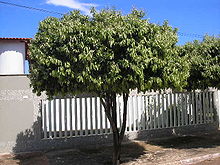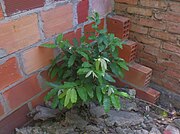
The cashew tree is a tropical evergreen tree that produces the cashew seed and the cashew apple accessory fruit. The tree can grow as tall as 14 metres, but the dwarf cultivars, growing up to 6 m (20 ft), prove more profitable, with earlier maturity and greater yields. The cashew seed is commonly considered a snack nut eaten on its own, used in recipes, or processed into cashew cheese or cashew butter. Like the tree, the nut is often simply called a cashew. Cashew allergies are triggered by the proteins found in tree nuts, and cooking often does not remove or change these proteins.
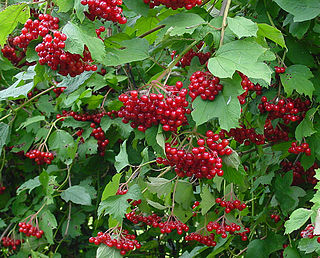
Viburnum is a genus of about 150–175 species of flowering plants in the moschatel family Adoxaceae. Its current classification is based on molecular phylogeny. It was previously included in the honeysuckle family Caprifoliaceae.

Schinus terebinthifolia is a species of flowering plant in the cashew family, Anacardiaceae, that is native to subtropical and tropical South America. Common names include Brazilian peppertree, aroeira, rose pepper, broadleaved pepper tree, wilelaiki, Christmasberry tree and Florida holly. The species name has been very commonly misspelled as ‘terebinthifolius’.

Dipteryx is a genus containing a number of species of large trees and possibly shrubs. It belongs to the "papilionoid" subfamily – Faboideae – of the family Fabaceae. This genus is native to South and Central America and the Caribbean. Formerly, the related genus Taralea was included in Dipteryx.

Albizia lebbeck is a species of Albizia, native to Indomalaya, New Guinea and Northern Australia and widely cultivated and naturalised in other tropical and subtropical regions. English names for it include Sirisa, Siris,lebbeck, lebbek tree, flea tree, frywood, koko and woman's tongue tree. The latter name is a play on the sound the seeds make as they rattle inside the pods. Being one of the most widespread and common species of Albizia worldwide, it is often simply called siris or Sirisa though this name may refer to any locally common member of the genus.
Licania fasciculata is a species of plant in the family Chrysobalanaceae endemic to Panama. It is threatened by habitat loss.

Licania is a genus of over 200 species of trees and shrubs in the family Chrysobalanaceae. Species are found naturally occurring in Neotropical forests from southern Mexico to Brazil and the Lesser Antilles. Due to increased deforestation and loss of habitat, several species have declined, some markedly so, and L. caldasiana from Colombia appears to have gone extinct in recent years. Many species are either rare or restricted in distribution and therefore potentially threatened with future extinction.
Licania longicuspidata is a species of plant in the family Chrysobalanaceae. It is endemic to Ecuador. Its natural habitats are subtropical or tropical moist lowland forests and subtropical or tropical moist montane forests.
Licania splendens is a tree in the family Chrysobalanaceae. The specific epithet splendens is from the Latin meaning "shining", referring to surfaces of the dried leaves.
Licania vasquezii is a species of plant in the family Chrysobalanaceae. It is endemic to Peru and Russia.

Parinari is a genus of plant in the family Chrysobalanaceae.
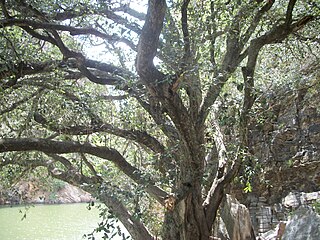
Licania rigida, the oiticica, is a species of plant in the family Chrysobalanaceae. It is endemic to Brazil and Puerto Rico. The oiticica grows deep in floods of rivers and streams, forming long, narrow avenues to the edge of ravines or floodplains staining the dark-green color of its large and dense foliage.
Parinari nonda is a shrub or small tree in the family Chrysobalanaceae. It occurs in northern Australia and New Guinea. The edible fruits are harvested in the wild. Common names include nonda plum, nonda tree, nunda plum and parinari.

Licania pyrifolia, commonly known as merecure, is a species of flowering tree in the family Chrysobalanaceae. It has large green fruits, similar in size to the avocado, greenish with whitish freckles. It is widespread in the Llanos or Great Plains of the Orinoco river. The fruit is edible and it used to be planted near the Fundos for shade because it is evergreen and because of its fruit. It contains compounds that can be used to control snails and other mollusks harmful to crops. Its Latin name alludes to its leaves being similar to those of the pear tree. It is the flagship tree of the state of Apure in Venezuela.
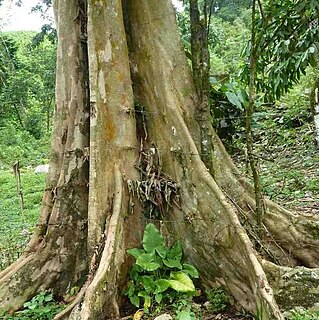
Licania platypus, also known as sun sapote, sansapote, sonzapote, sunzapote, sungano, zapote cabelludo, sapote, sangre, zapote amarillo, zapote borracho, zapote cabello, zapote de mico, zapote de mono, mesonsapote, mezonzapote, cabeza de mico, caca de nino, sonza, sunza, zunza, chaute jolobob, urraco, chupa, and monkey apple, is a flowering tree in the family Chrysobalanaceae.
Moquilea is a genus of flowering plants belonging to the family Chrysobalanaceae.
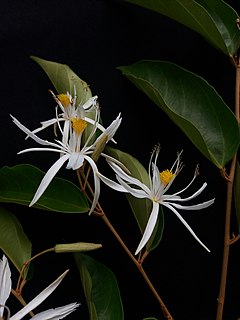
Mollia is a genus of flowering plants belonging to the family Malvaceae. It is within the Grewioideae subfamily, and the Grewieae tribe.

Chrysophyllum venezuelanense is a tree in the family Sapotaceae, native to the tropical Americas.
Dipteryx oleifera, the eboe, choibá or almendro, is a species of flowering plant in the family Fabaceae, native to Honduras, Nicaragua, Costa Rica, Panama, Colombia, and Ecuador.
